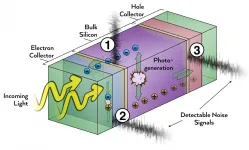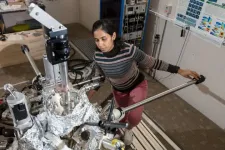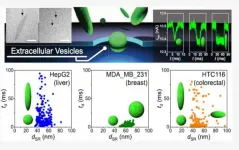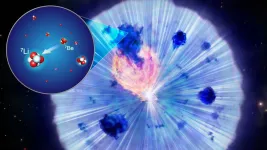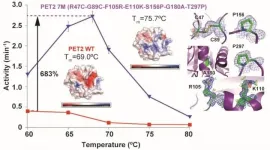INFORMATION:
This work is a culmination of a five-year collaborative study, which first began at UQ's Institute for Molecular Bioscience, and is led by UQ Diamantina Institute's Professor Brandon Wainwright and Associate Professor Melissa Davis, a computational biologist from WEHI, along with a team of national and international collaborators.
The research was funded by the US National Institutes of Health, the Seattle Children's Brain Tumour Endowment, the Kids Cancer Project, Brainchild, the Children's Hospital Foundation, The Pirate Ship Foundation, Cure Brain Cancer, the National Breast Cancer Foundation, The Betty Smyth Centenary Fellowship and the Victorian Government.
New generation anti-cancer drug shows promise for children with brain tumours
2021-07-07
(Press-News.org) A genetic map of an aggressive childhood brain tumour called medulloblastoma has helped researchers identify a new generation anti-cancer drug that can be repurposed as an effective treatment for the disease.
This international collaboration, led by researchers from The University of Queensland's (UQ) Diamantina Institute and WEHI in Melbourne, could give parents hope in the fight against the most common and fatal brain cancer in children.
UQ lead researcher Dr Laura Genovesi said the team had mapped the genetics of these aggressive brain tumours for five years to find new pathways that existing drugs could potentially target.
"These are drugs already approved for other diseases or cancers but have never been tested in paediatric brain tumours," Dr Genovesi said.
"In this study, we predicted a drug called Ixabepilone, typically used to treat breast cancer, would block tumour growth and significantly extend the survival rate in preclinical models."
Associate Professor Melissa Davis, joint senior author from WEHI, said the chemotherapy drug had a 'dramatic survival benefit', with very little sign of any remaining tumour following treatment.
"This is the second drug that we have identified using the genetic map that's highly effective in treating this type of childhood brain cancer," Associate Professor Davis said.
"The impact of this drug in our model systems gives hope for children diagnosed with highly aggressive forms of medulloblastoma.
"But even more promising, is the potential to use our genetic map to find other treatments for this disease."
Associate Professor Davis likened their work to a street map.
"Like a map shows streets connecting places, the genetic map shows connections between different genes that contribute to more aggressive brain tumours," she said.
Dr Genovesi said drugs that could block these connections were more likely to be effective in treating the cancer, giving researchers a head start on the best possible treatment options.
"We're really using biology to define the next round of drugs that will hopefully have a fantastic benefit for children with this condition," Dr Genovesi said.
"This gives us the best chance to identify drugs that will have the least impact on the normal developing brain, an important consideration for paediatric brain cancers.
"At the moment, the side-effects of treatment can be almost impossible for families to live with.
"Short-term, we are looking at existing drugs that can target certain overlapping areas on the genetic map.
"But long-term, we now have an entire list of proteins and pathways that new therapeutics could target that we know would kill cancer cells, and we want to work with drug companies to try and develop these life-saving medications."
ELSE PRESS RELEASES FROM THIS DATE:
Not only humans got talent, dogs got it too!
2021-07-07
Some exceptionally gifted people have marked human history and culture. Leonardo, Mozart, and Einstein are some famous examples of this phenomenon.
Is talent in a given field a uniquely human phenomenon? We do not know whether gifted bees or elephants exist, just to name a few species, but now there is evidence that talent in a specific field exists, in at least one non-human species: the dog.
A new study, just published in Scientific Reports, found that, while the vast majority of dogs struggle to learn object labels (such as the names of their toys), when tested in strictly controlled conditions, a handful of gifted word learner ...
Cutting through noise for better solar cells
2021-07-07
As society moves towards a renewable energy future, it's crucial that solar panels convert light into electricity as efficiently as possible. Some state-of-the-art solar cells are close to the theoretical maximum of efficiency--and physicists from the University of Utah and Helmholtz-Zentrum Berlin have figured out a way to make them even better.
In a new study, physicists used a technique known as cross-correlation noise spectroscopy to measure miniscule fluctuations in electrical current flowing between materials inside silicon solar cells. The researchers identified crucial electrical ...
Harnessing AI to discover new drugs
2021-07-07
Nature has a vast store of medicinal substances. "Over 50 percent of all drugs today are inspired by nature," says Gisbert Schneider, Professor of Computer-Assisted Drug Design at ETH Zurich. Nevertheless, he is convinced that we have tapped only a fraction of the potential of natural products. Together with his team, he has successfully demonstrated how artificial intelligence (AI) methods can be used in a targeted manner to find new pharmaceutical applications for natural products. Furthermore, AI methods are capable of helping to find alternatives to these compounds that have the same effect but are much easier and therefore cheaper to ...
Researchers identify ultrastable single atom magnet
2021-07-07
Researchers at the IBS Center for Quantum Nanoscience at Ewha Womans University (QNS) have shown that dysprosium atoms resting on a thin insulating layer of magnesium oxide have magnetic stability over days. In a study published in Nature Communications they have proven that these tiny magnets have extreme robustness against fluctuations in magnetic field and temperature and will flip only when they are bombarded with high energy electrons through the STM-tip.
Using these ultra-stable and yet switchable single-atom magnets, the team has shown atomic-scale control of the magnetic field within ...
Anti-androgen therapy can fuel spread of bone tumours in advanced prostate cancer
2021-07-07
Dr Bock, under the mentorship of Distinguished Professor Dietmar Hutmacher, from QUT Centre for Biomedical Technologies, has focused her research on bone metastases from breast and prostate cancers.
She developed 3D miniature bone-like tissue models in which 3D printed biomimetic scaffolds are seeded with patient-derived bone cells and tumour cells to be used as clinical and preclinical drug testing tools.
The research team investigated their hypothesis that traditional anti-androgen therapy had limited effect in the microenvironment of prostate cancer bone tumours. The team's findings are published in Science Advances.
"We wanted to see if the therapy could be a contributor of cancer cells' adaptive responses that fuelled bone ...
The shape of nanoparticles in body fluids may help identify the type of cancer
2021-07-07
A recent study by scientists from Japanese universities has shown that the shape of cell-derived nanoparticles, known as "extracellular vesicles" (EVs), in body fluids could be a biomarker for identifying types of cancer. In the study, the scientists successfully measured the shape distributions of EVs derived from liver, breast, and colorectal cancer cells, showing that the shape distributions differ from one another. The findings were recently published in the journal Analytical Chemistry.
Early detection of cancerous tumors in the body is essential for ...
Mount Sinai research reveals how Ebola virus manages to evade the body's immune defenses
2021-07-07
New York, NY (July 6, 2021) - Mount Sinai researchers have uncovered the complex cellular mechanisms of Ebola virus, which could help explain its severe toll on humans and identify potential pathways to treatment and prevention. In a study published in mBio, the team reported how a protein of the Ebola virus, VP24, interacts with the double-layered membrane of the cell nucleus (known as the nuclear envelope), leading to significant damage to cells along with virus replication and the propagation of disease.
"The Ebola virus is extremely skilled at dodging the body's immune defenses, and in our study we characterize an important way in which that evasion occurs through disruption of the nuclear envelope, mediated by the VP24 protein," says co-senior ...
Anti-coagulant drug could treat COVID-19's emerging variants
2021-07-07
QUT PhD researcher Zachariah Schuurs said the research team had identified a new binding site on the SARS-CoV-2 spike protein.
"Binding of the CoV-2 spike protein to heparan sulphate (HS) on cell surfaces is generally the first step in a cascade of interactions the virus needs to initiate an infection and enter the cell.
"Most research has focused on understanding how HS interacts on the receptor-binding domain (RBD) and furin cleavage site of the SARS-CoV-2 virus's spike protein, as these typically bind different types of drugs, vaccines and antibodies.
"We have identified a novel binding site on the N-terminal domain (NTD), a different area of the virus's spike that facilitates the binding of HS. This helps to better understand how the virus ...
Small amount of lithium production in classical nova
2021-07-07
A new study of lithium production in a classical nova found a production rate of only a couple of percent that seen in other examples. This shows that there is a large diversity within classical novae and implies that nova explosions alone cannot explain the amount of lithium seen in the current Universe. This is an important result for understanding both the explosion mechanism of classical novae and the overall chemical evolution of the Universe.
In the modern world, lithium is used in the rechargeable batteries powering smartphones and other devices. ...
Engineered protein inspired by nature may help plastic plague
2021-07-07
Cheap to produce and long to degrade, plastic was once a manufacturing miracle. Now, plastic is an environmental plague, clogging landfills and choking waterways. A Japan-based research team has turned back to nature to develop an approach to degrading the stubborn substance. Similar to how a protein binds to cellulose in plants or to chitin in crustaceans to initiate decomposition, an engineered protein is on its way to binding to plastic particles in an effort to more efficiently break them down.
They published their results on June 29 in ACS Catalysis, a journal of the American Chemical Society.
"Polyethylene ...


